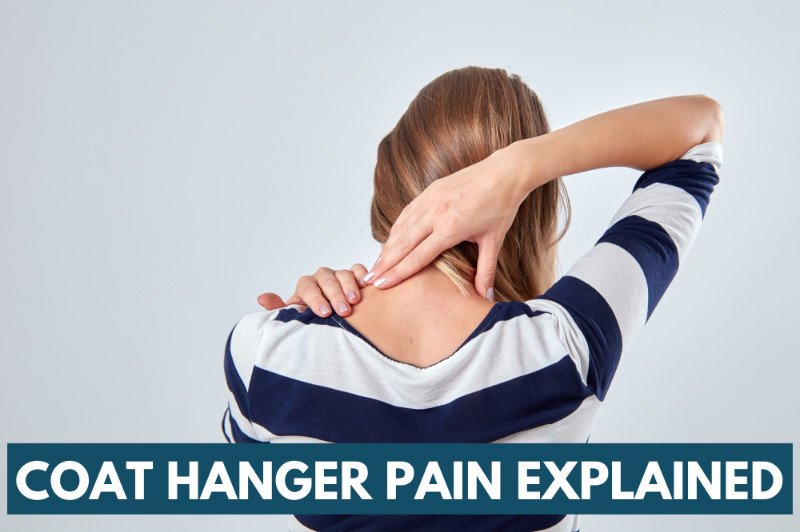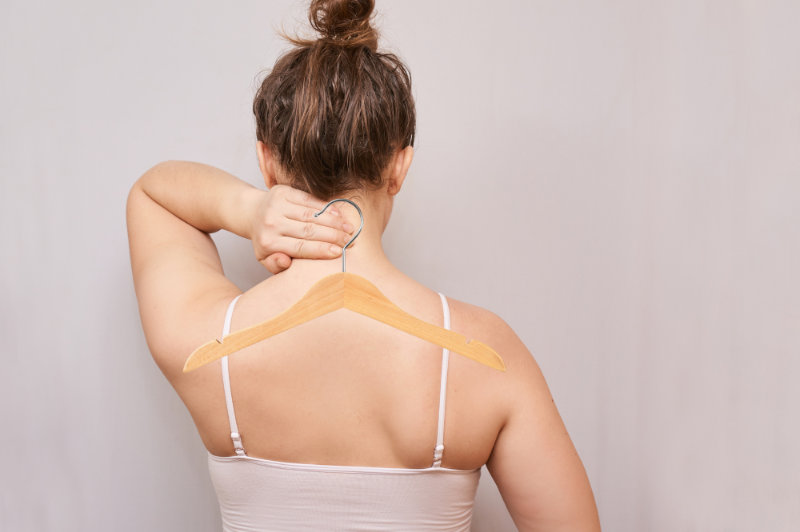
Coat hanger pain is a pain in the neck and upper back, specifically the suboccipital and paracervical regions. It has been described as a “charley horse” kind of sensation in the back of the neck and shoulders. This pattern mimics the shape of a coat hanger with the hook in the neck and the body spreading out across the upper trapezius muscles and shoulders.
Similar to headaches, this is such a common type of pain in the EDS / HSD community. There can be several contributing factors to this pain which this article will explore in greater detail. As there are many factors, we need to appreciate how these work together and adopt some strategies to overcome coat hanger pain.

Exploring the causes behind the pain
Orthostatic intolerance and lack of blood low
Coat-hanger pain is also very commonly found in people with conditions that affect the autonomic nervous system (dysautonomia) such as orthostatic hypotension (OH) multiple system atrophy (MSA), and potentially POTS (1, 2, 3). 93% of patients with pure autonomic failure report coat-hanger pain (2).
Coat-hanger pain that improves with sitting or lying down is listed as a symptom in a recent article for providers on how to assess autonomic conditions and obtain a comprehensive medical history (4). One theory is that because the neck muscles are anti-gravity muscles and are always actively supporting the neck, they are continuously using the oxygen that is delivered to them in the blood. If the blood flow falls below what is needed (such as occurs in people with orthostatic intolerance) the waste products of the muscle activity build-up, which can induce pain (4).
In one study of people with OH, 59% reported coat-hanger pain during their daily activities (3). This study also found that the severity of the pain, as well as the association with other OH symptoms, and how long people needed to recover after laying down, was highly variable among the participants. They suggest this points to the complexity of the condition and probably not just a lack of blood flow to the muscles. Stimulation of other structures in the head and neck can produce the same pain pattern. They even mention that many of their patients had a loss of vagal nerve function that could alter the headache threshold (3).
Muscle tension patterns
I often see this pain pattern in my clients who have a particular pattern: tight muscles at the front of the body and long, stringy muscles in the back body. We are out of balance, so muscles fatigue and complain leaving this nagging daily pain. Our posture tends to mimic this with a forward slump and rounded shoulders, maybe a winging scapula. Forward head posture and associated neck pain can follow.
Interestingly, you may also find with this type of posture that a neck hump is developing on the back of your neck. People are often concerned about this development. The reason behind this hump on the back of the neck is due to a laying down of fascia . Fascia responds to force and pressure traveling through the connective tissue.
With a forward head posture, the head weight increases significantly, causing sheering on the vertebrae. The body begins to lay down a fat pad of fascia over time to protect the joints. With appropriate treatment, exercise, and posture I see these fat pads diminish in my clients. The fascia has an amazing ability to remodel itself. If we change the forces traveling excessively through a couple of joints, we can change the presentation of the fascia.
While the cause of coat-hanger pain is believed to be multi-factorial, both dysautonomia and postural issues could likely contribute to the lack of blood flow to these muscles leading to pain. The good news is there are things to try to manage this pain. We will discuss this below.
Identifying symptoms and the diagnostic process
It is always important to see a medical professional like an EDS-aware physical therapist or physiotherapist if you are experiencing new types of neck and shoulder pain. They can help identify the cause of the pain and appropriate manual therapy may be useful in relieving some of the pain symptoms so that you can start to exercise and bring balance to the structure. You can find a list of providers who have been trained in my Integral Movement Method here , many of which are physical therapists and physiotherapists.
Home management strategies
There are many strategies we can try to alleviate this condition. Some of these include:
- Hydration
- Maintaining hydration can reduce orthostatic and coat-hanger headaches due to dysautonomia (5).
- Heat
- May increase blood flow to the area and relax the overworked muscles.
- Movement
- Can help increase blood flow to the area and hydrate the fascia.
- Counterpressure maneuvers to get the blood pumping back to the head (6)
- Things like Leg-crossing, calf pumps, squatting, etc.
- Address posture and strength
- We can change the coat-hanger so that it does hold us up in alignment rather than feeling the coat is too heavy! Exercise can really target this area.
- Address pain sensitization
- Addressing nociplastic pain through nervous system regulating strategies
- Breathing
- Starting with supine breathing exercises can help allow the muscles to relax. The use of gravity to allow the bones to settle can release habitual tension from the upper back tissues. Once we have relaxed those muscles, we can start implementing some appropriate hypermobility/EDS stability and strengthening exercises. Want to try some breathing exercises? Check out this video.
- Any other strategies
- It can be worth addressing ergonomic desk setup or driving positions to make sure we are not exacerbating a coat hanger position during our daily activities.
Emily Rich, OT recently joined us in The Zebra Club. and gave a fantastic presentation on the non-pharmacological management of POTS. Members can find this in the resource section. This will provide additional resources for addressing postural orthostatic challenges that contribute to coat hanger pain.
Seeking professional care
If you find that your coat-hanger pain improves with lying down it may be especially beneficial to discuss with your doctor, this can be a symptom of many different types of dysautonomia. Many things can be done to address some of the symptoms of dysautonomia from medication to lifestyle interventions like salt intake and compression. Dysautonomia International has a providers directory that may help.
Want to try some exercises to start to address your coat-hanger pain? Here is one video I created to address this.
If you like that one, I have a full-length Coat Hanger Pain class created by popular request. This one has been very popular since I added it to the video library in The Zebra Club.
Literature review/research by Catherine Nation MSc, PhD
Works Cited
- Cook & Sandroni (2018). Management of headache and chronic pain in POTS. Autonomic Neuroscience: Basic and Clinical.
- Bleasdale-Barr & Mathias (1998). Neck and other muscle pains in autonomic failure: their association with orthostatic hypotension. Journal of The Royal Society of Medicine.
- Khurana (2012). Coat-hanger ache in orthostatic hypotension. Cephalgia.
- Goldstein & Cheshire (2017) The Autonomic Medical History. Clinical Autonomic Research.
- Arca & Sing (2021). Dehydration and Headache. Current Pain and Headache Reports.
- Williams et al (2022). Counter pressure maneuvers for syncope prevention: a semi-systemic review and meta-analysis. Frontiers in Cardiovascular Medicine.
2 Comments
Ian Mitchell - 20th February 2024
Where can we find the links to the YouTube series you mentioned?
Jeannie Di Bon - 22nd February 2024
Thank you. Here is a link to my YouTube channel.
Jeannie di Bon on Youtube